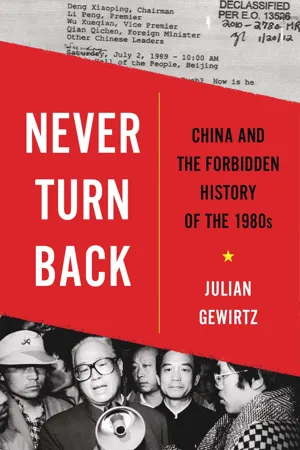
- English
- ePUB (mobile friendly)
- Available on iOS & Android
About This Book
A Foreign Affairs Best Book of the Year
A BBC History Magazine Best Book of the Year "Excellent…A fascinating, authoritative account of the paths for China's future explored during a decade long buried by official, state-sponsored history."—Julia Lovell, Foreign Policy "A vivid and readable account…Exceptionally well-researched." —Andrew Nathan, Foreign Affairs "The definitive book on China in the 1980s in terms of the depth of research and originality of the argument." ?Minxin Pei, author of The Sentinel State "A gift to our understanding of today's China."?Evan Osnos, author of Age of Ambition On a hike in Guangdong Province in January 1984, Deng Xiaoping was warned that his path was a steep and treacherous one. "Never turn back, " the Chinese leader replied. That became a mantra as the government forged ahead with reforms in the face of heated contestation over the nation's future.Recovering the debates of China in the 1980s, Julian Gewirtz traces the Communist Party's diverse attitudes toward markets, state control, and sweeping technological change, as well as freewheeling public argument over political liberalization. Deng Xiaoping's administration considered bold proposals from within the party and without, but after Tiananmen, Beijing systematically erased these discussions of alternative directions. Using newly available Chinese sources, Gewirtz details how the leadership purged the key reformist politician Zhao Ziyang, quashed the student movement, recast the transformations of the 1980s as the inevitable products of consensus, and indoctrinated China and the international community in the new official narrative. Never Turn Back offers a revelatory look at how different China's rise might have been and at the foundations of strongman rule under Xi Jinping, who has intensified the policing of history to bolster his own authority.
Frequently asked questions
Information
Table of contents
- Cover
- Title Page
- Copyright
- Contents
- Introduction ◇ Forbidden History
- 1. Reassessing History, Recasting Modernization
- Part I ◆ Ideology and Propaganda
- Part II ◆ The Economy
- Part III ◆ Technology
- Part IV ◆ Political Modernization
- Part V ◆ Before Tiananmen
- Part VI ◆ Tiananmen and After
- Conclusion ◇ A New Era
- Illustrations
- Abbreviations
- Notes
- Acknowledgments
- Index